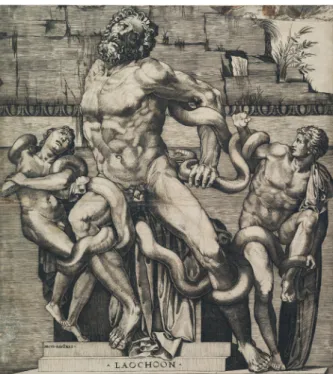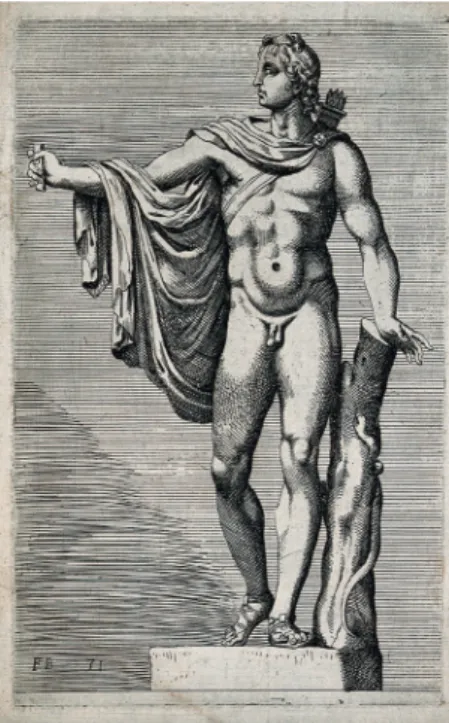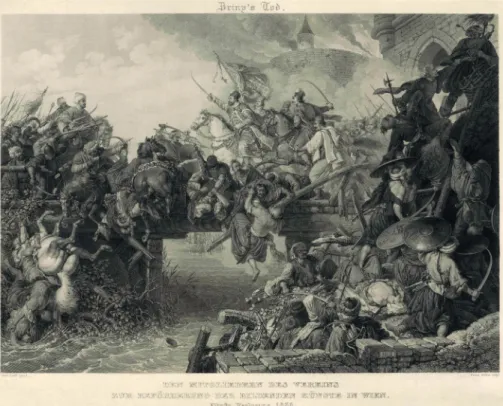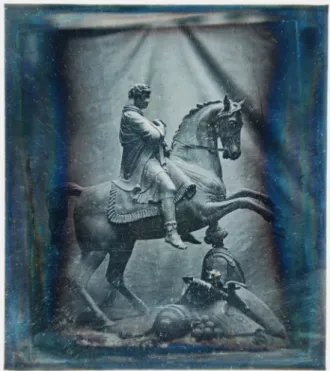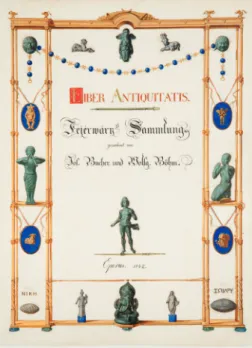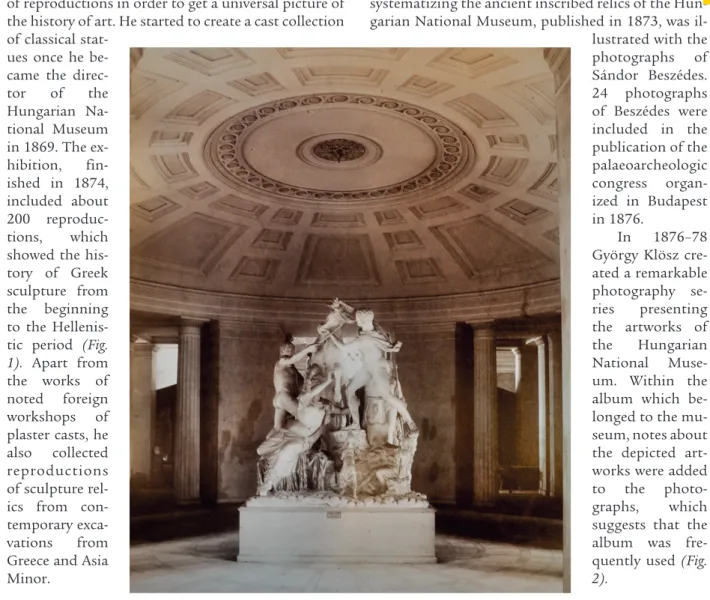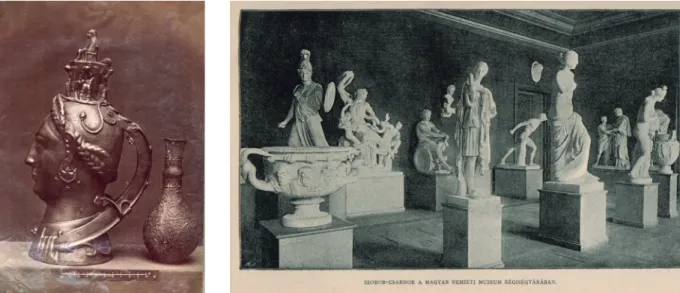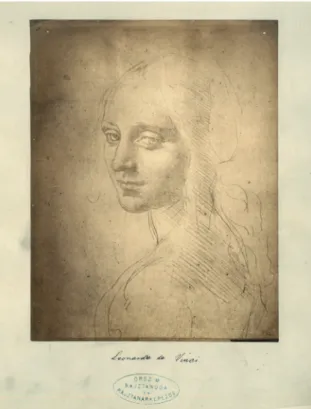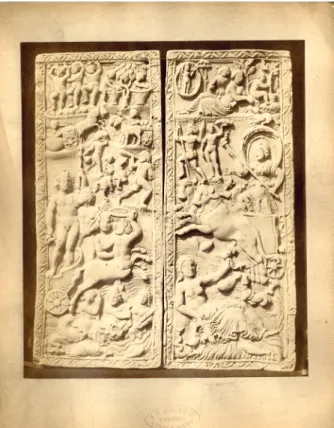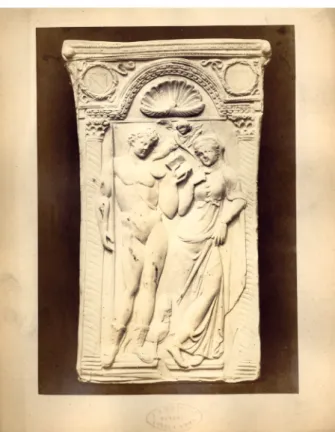Júlia Papp
“Present of Ferencz Pulszky”
Júlia Papp
“Present of Ferencz Pulszky”
Engraving, Plaster Cast, Photograph – Chapters from the History of Artwork Reproduction
Lutheran Central Museum, Budapest 26 March – 26 August 2020
Exhibition Guide
Budapest, 2020
The exhibition has been accomplished within the framework of a cooperation between the Lutheran Central Museum and the Research Centre for the Humanities, Institute of Art History
Curator: Júlia Papp
Organizers: Júlia Papp, Virág Somogyvári, Béla Harmati Translation: Virág Somogyvári, Rebeka Szaló
Proofreading: Virág Somogyvári, Rebeka Szaló, Helen Rufus-Ward Designer: István Ágoston
The institutions the exhibits are borrowed from:
Department of Art History, University of Vienna Budapest City Archives
ELTE University Library, Budapest Hungarian National Museum, Budapest Hungarian University of Fine Arts, Budapest
Library and Information Centre of the Hungarian Academy of Sciences, Budapest Metropolitan Ervin Szabó Library, Budapest
Museum of Applied Arts, Budapest Museum of Fine Arts, Budapest National Széchényi Library, Budapest Schola Graphidis Art Collection, Budapest
The concept of the exhibition and the exhibition guide is based on the catalogue titled Júlia Papp & Benedetta Chiesi (eds. / szerk.): John Brampton Philpot’s photographs of fictile ivory / John Brampton Philpot fényképsorozata elefántcsont faragványok másolatairól. Budapest 2016.
Accompanying event of the exhibition: Engraving, Plaster Cast, Photograph – Chapters from the History of Artwork Reproduction. International workshop (27 August 2020, Lutheran Central Museum, Budapest).
The international workshop is an event accompanying the exhibition about the history of artwork reproduction organized in the Lutheran Central Museum in Budapest between 26 March, 2020 and 26 August, 2020.
International (English, Italian, Portuguese, Austrian, German, Slovakian) and Hungarian scholars present the different areas of the history of artwork reproduction, from the Renaissance engraving copies of paintings to plaster casts and the photographs created of relics of architecture and fine arts. The directors of a few reproduction collections present the history and details of their collection.
© RCH, Júlia Papp ISBN 978-963-416-218-6
Published by the Research Center for the Humanities, Institute of Art History.
Printed in Hungary, by Krónikás Bt., Biatorbágy
casts started to decline, and the 19th century artwork photographs of museums and educational institutions were also gradually replaced by more and more repro- ductions. The interest towards collections of plaster casts and artwork photographs have started to grow only in the recent
decades. The re- stored art reproduc- tion collections once more have a signifi- cant role in educa- tion, museum peda- gogy and the teaching of general knowledge. Moreo- ver, today reproduc- tions which are hun- dreds of years old are also more and more often consid- ered to be autono- mous artworks in their own right be- cause of their age.
ur exhibition provides insight into John Brampton Philpot’s photographs of fictile ivories, given to the Hungarian National Museum as the “present of Ferencz Pulszky”
in 1870, as well as on the history of European art reproduction. From ancient times, the reproduction of artworks has served the conservation of cultural traditions. The famous marble statue of the Apollo Belvedere is a Roman replica from the 2nd century of a Greek bronze statue, although in the 19th century it was regarded as one of the masterpieces of classical Greek art (Fig. 1).
Artwork reproductions had a significant role in the education of artists since the Renaissance. Addi- tionally, reproductive graphics (Fig. 2) played a funda- mental role in spreading the elements of form in fine
arts, applied arts and archi tecture. In the second half of the 19th century, the plaster cast collections of museums had important roles in the over all educa- tion and the im provement of the aesthetic judgment of the general public. The public could finally see the artworks of different collections in one place and at the same time. As travelling became more common, and the opportunities for tourism started to increase, the cheap photography series and postcards of the valuable
artworks of museums became extremely popular (Fig. 3).
In the beginning of the 20th century, the popularity of plaster
O
Fig. 1. The Apollo Belvedere, 2nd century, Vatican Museum, Rome
Fig. 2. Marco Dente: Laocoon. Engraving, around 1520–25
Fig. 3. Artwork photograph of the Alinari Company, end of the 19th century
I. Artwork Reproduction in the 16
th–19
thCenturies
The woodcut illustrations presenting the liturgical objects of European cathedrals, published in the books called Heiltumsbuch from the end of the 15th century onwards, can be classified as early artwork re- productions (Fig. 1).
The plaster casts of ancient statues, produced in Italian workshops, had their own place in the collec- tions of European rulers and aristocrats from the beginning of the 16th century, and were also popular among artists and wealthy burghers. From the 16th century onwards, many graphic reproductions of ancient statues were created. The changes on the original objects were also occasionally visible on the reproductions: while on the engraving of Marcantonio Raimondi from the beginning of the
16th century (see in the display case) the Apollo Belvedere is presented with partially missing hands, in a later illustration the statue is seen with restored hands (Fig. 2).
The first modern publication of reproductions, which included the engravings of the most beautiful Italian paintings and drawings kept in French collections, was published in 1729–1742 with Pierre Crozat as its editor. The monumental series titled Trésor de numismatique et de glyptique (1834–1850) included more than 15000 artworks and had illustrations made by a new method of engraving invented by the French engineer, Achille Collas (Fig.
3). These reproductions were much more accurate, realistic and successful at illustrating the plasticity of the objects than drawings made by hand or engravings based on drawings.
Exhibits
The statue found at Antium (Anzio) in 1489 had a damaged right hand and a missing left hand. Around 1532–1533, Giovanni Agnolo Montorsoli amputated the damaged hand at the elbow and made a new one to replace it. The statue had its hands restored on the images made in the 1540s by Francisco de Holanda, and a hundred years later by Francois Per- rier, and most of the plaster cast re- productions created in the 17–18th centuries also reflected this state.
However, in the 19th century, differing opinions started to be voiced against Montorsoli’s addi- tions.
Fig. 1. Die zaigung des hochlobwirdigen heiligthumbs der Stifftkirchen aller hailigen zu Wittenburg. Wittenberg, 1509. Herzog August Bibliothek
Fig. 2. Francois Perrier: The Apollo Belvedere.
Engraving. Segmenta nobilium signorum e statuarii... Rome, 1638. [Figs. 30–31]
The publisher of the pocket book, Sámuel Igaz, believed that the underdevelopment of Hungarian fine arts was not caused by the inability of Hungarians to engage in artistic activities, but by the fact that they had no academy where they could study art and a public gallery open to everyone.
By publishing engravings of the masterpieces of the classical masters, he sought to spread the knowledge about fine arts.
While earlier engraving albums about famous sculpture or drawing collections and art galleries were primarily made for representational purposes, from the end of the 18th century the engraving reproductions of artworks, that were in almanacs and poetry volumes, also played an important part in the 1. Marcantonio Raimondi: Apollo
Belvedere. Engraving. Around 1527.
Museum of Fine Arts, Prints and Drawings
2. Jean Dughet after Nicolas Poussin’s painting: Rest on the Flight into Egypt.
Engraving, etching.
1655–1658. Museum of Fine Arts, Prints and Drawings
3. Johann Blaschke: The Abduction of Ganymede. After Correggio’s painting. In: Hébe Zsebkönyv. Published by Sámuel Igaz. Vienna, 1826. National Széchényi Library
3. kép. Toinette Larcher rézmetszete Raffaello festménye után: Judit. In: Recueil d’estampes d’après les plus beaux tableaux et d’après les plus beaux desseins qui sont en France… Tome premier.
Contenant l’Ecole Romaine. Paris, 1729. 33. kép
4. Peter Krafft – Franz Stöber: Zriny’s Tod (Zrinyi’s Death). Engraving. 1836. Hungarian National Museum, Historical Gallery
5. Scene from the Life of Joseph. Plaster cast of an ivory carving. Second half of the 19th century. Department of Art History, University, Vienna
betterment of the aesthetic judgment of the readers and the dissemination of knowledge. Instead of only paying attention to the art of earlier eras, there was now an increasing focus on contemporary artworks as well. An engraving reproduction of a monu- mental painting of Peter Krafft, which depicted Miklós Zrínyi’s charge from the fortress of Szigetvár, published by the Kunstverein of Vienna in 1836, became extremely popular in Eastern Europe.
The painting and the engraving – for the first time in fine arts – also included the valiant wom- an of Szigetvár, whose legend has often been part of Hungarian and foreign historiography and literature since the 16th cen- tury.
II. The Artwork Reproduction Movement in the 19
thCentury
In the 19th century, purchasing plaster casts became more and more popular both among private individuals and institutions. The British Museum started to sell plaster cast artwork reproductions from 1836, and in 1838 published a commercial catalogue about the prices of the reproductions of the Elgin Marbles kept in the museum. In 1854 at Sydenham, a monumental plaster cast exhibition presented the history of architecture in 10 exhibition halls in the rebuilt and extended Crystal Palace (Fig. 1).
The first director of the South Kensington Museum, Henry Cole organized an international convention in 1867, which was signed by 15 European crown princes. The convention intended to move forward the mutual exchange of reproductions in Fig. 1. The Roman Court in Sydenham. After 1854. Lithography Fig. 2. Cast Courts. Victoria and Albert Museum, London
European museums. In 1873, the reproductions of architectural monu- ments, as well as of sculptures were exhibited in the just opened monumental twin halls (today known as the Cast Courts) (Fig. 2).
Not only comprehensive plaster cast collections were kept in museums (e.g. Neues Museum in Berlin, Palais du Trocadero in Paris) but some other collectors gathered special cast pieces: in 1884 the Royal Academy of Fine Arts of Lisbon purchased a set of reproductions of armoury objects like shields and helmets, the majority of which were casts of the originals kept in the Royal Armoury of Madrid (Fig. 3).
The European reproduction movement – producing, selling and exchanging plaster casts and photography reproductions – had a main role in the evolution of modern art historian research by making it possible for scholars to have an overview of the history of styles for specific groups of artworks and relics.
Exhibits
1. Edmund Oldfield: Catalogue of select examples of Ivory- Carvings from the second to the sixteenth century, preserved in various public and private collections in England and other countries, casts of which, in a material prepared in imitation of the originals, are sold by the Arundel Society. London, 1855.
Museum of Applied Arts, Library
In 1855, the Arundel Society in London, which often commissioned fictile ivories, requested Edmund Oldfield, a member of the society’s council and one of the founding members, to classify the fictile ivories representing several different schools and periods. The published catalogue described the reproductions available for purchase and their prices.
In 1856, the Arundel Society published the revised version of Oldfield’s catalogue, illustrated with 9 albumin photographs by J.
A. Spencer. The catalogue included around 150 reproductions, as well as a pair of 12 items depicting the details of the ivory casket of the Cathedral of Sens, and Oldfield’s description of the reproduction process itself. The reproductions, Fig. 3. Helmet. Plaster cast. Around 1884.
© Faculty of Fine Arts of the University of Lisbon, Portugal
2. Matthew Digby Wyatt – Edmund Oldfield: Notices of Sculpture in Ivory, consisting of a Lecture on the History, Methods, and Chief Productions of the Art, Delivered at the First Annual general Meeting of the Arundel Society, on the 29th June, 1855, and a Catalogue of Specimens of Ancient Ivory-Carvings in Various Collections. London, 1856. Museum of Applied Arts, Library
organized in a chronological order, were then exhibited in the society’s office.
In 1876, the South Kensington Museum published a monumental catalogue (975 items) illustrated with 24 photographs of the fictile ivories belonging to the institution. The purpose of obtaining the reproductions was to expand the museum’s remarkable collection of original ivory carvings. Westwood looked through the European collections of ancient and medieval ivory carvings to draw attention to the valuable artworks a reproduction should also be obtained of.
The success of the 19th century European art reproduction movement is shown by the fact that the items in the catalogue of plaster molds, the first to be used in the education of industrial drawing, published in London in 1854 by Ralph Nicholson Wornum, later appeared in the plaster collections of schools. For example, the art collection of the Schola Graphidis in Budapest includes a Renaissance ornamental plaster mold made in the beginning of the 20th century for students of the Felső Ipariskola, an industrial school, which can also be found in the catalogue published in London.
4. Plaster cast of a Renaissance ornament. Beginning of the 20th century. Schola Graphidis Art Collection
3. John Obadiah Westwood: A Descriptive Catalogue of the Fictile Ivories in the South Kensington Museum. With an Account of the Continental Collections of Classical and Mediaeval Ivories.
London, 1876. Museum of Applied Arts, Library
6. Plaster cast atelier of the Hungarian Royal Trade School (Budapest): Renaissance frieze. Beginning of the 20th century. Schola Graphidis Art Collection
7. Plaster cast atelier of the Hungarian Royal Trade School (Budapest): Romanesque frieze. Beginning of the 20th century.
Schola Graphidis Art Collection
5. Renaissance ornamental pattern. In: Nicholson Wornum:
Catalogue of ornamental casts in the possession of the Department, Third Division: the Renaissance styles by Great Britain. Dept. of Science and Art.
London, 1854. Reproduction
III. Artwork Photography in the 19
thCentury
The spread of photography in the 19th century brought a revolutionary change even in art reproduction as it became possible to make significantly more accurate reproductions than previously with drawings and engravings. The photographs taken by William Henry Fox Talbot of the plaster casts of Patroclus’ marble bust from the British Museum in the 1840s are among the early examples of artwork photography (Fig. 1). In 1846, Adolf Góla made a daguerreotype series of the plaster models of the unrealized Matthias Monument of István Ferenczy (Fig. 2).
The 1850s in Western Europe saw the beginning of photographing architectural monuments and the most valuable artworks of major museums and collections. From the middle of the 19th century
onwards, European cultural institutions spent more and more on acquiring photography series depicting the artworks of public and private collections, temporary and permanent exhibitions, as well as architectural monuments, which were then used in the institutional system of historic preservation and education.
In Hungary the 1870s were the beginning of creating photographs of temporary exhibitions, as well as collections belonging to museums and ecclesiastical collections. The engraved illustrations in publications about art and monuments were more and more often based on photographs, and there was an increase in the number of scholarly books and journals which were illustrated with photographs glued onto the pages or pictures made with photomechanical methods.
Fig. 1. William Henry Fox Talbot: Patroclus’ Bust. Around 1843.
Salted paper
Fig. 2. Adolf Góla: Detail of the Matthias monument by István Ferenczy. Daguerreotype, 1846. Museum of Fine Arts, Budapest – Hungarian National Gallery
3. kép. Henric Trenk: A petrossai aranylelet.
Fénykép. 1863. Magyar Tudományos Akadémia Könyvtár és Információs Központ
Exhibits
1. Scale model of Palatin Joseph’s statue. Photograph.
1850s. Private Collection
In the second half of the 19th century in Hungary, there was a growing interest in collecting data related to old manuscripts of national relevance, mainly the 2. Díszlapok a római könyvtárakban őrzött négy Corvin-kódexből.
Pest, 1871. National Széchényi Library
3. Az Eszterházy Képtár eredeti fényképekben. Szövegét írta Keleti Gusztáv. Első folyam. Pest, 1871. Metropolitan Ervin Szabó Library, Budapest Collection
now scattered pieces of the famous library of King Matthias. Some of the codices kept in Constantinople were already studied by Hungarian scholars as early as 1862 and a list was made of them. In the end of the 1860s, members of the Hungarian episcopacy present at the Vatican Council commissioned photographs of Corvinas in libraries in Rome. The representative book, published in 50 copies, was illustrated by 16 high- quality photographs glued onto the pages, the images depicting codices like the Breviary of the Vatican, the
Regis Mathiae Corvini, the Opera Ciceronis and the Didymus Codex.
The Esterházy Gallery, open to the general public at the new palace of the Hungarian Academy of Sciences since 1865, was purchased by the Hungarian government in 1871. In the same year, an ornamental album was published about the collection with Antal Simonyi’s 10 photographs, in quarto and large folio sizes. In 1883, an ornamental book titled Landes- Gemälde Galerie in Budapest vormals Esterházy Galerie was published in Vienna with the study of Hugo von Tschudi and Károly Pulszky, illustrated with engravings and prints made with photomechanical techniques. In 1884, Antal Weinwurm was allowed to photograph the famous artworks in the Országos Képtár, a national picture gallery, and the Braun Company in Paris was granted permission to photograph the outstanding pieces of the collection. The library of the Museum of Fine Arts in Budapest has 18 real folio-sized photographs of one of the ornamental albums depicting the artworks of the Esterházy Gallery, published by the Braun Company in 1896.
The paintings of the Esterházy Gallery were photographed in a temporary open-rooftop workshop. In the foreground of the photograph we can see the building of the Academy, in the middle the quay and in the background the Chain Bridge. In the middle of the workshop is perhaps the photographer Gaston Braun. On the easel a portrait by Angelica Kauffmann was placed, painted in 1795 and depicting a dressing Lady Smith as Venus. The photograph could have been taken slightly from above, from the window of the building next to the Academy. We do not know whether the photographer chose the moment when the painting, from the end of the 18th century, was on the easel on purpose, or whether it is just a coincidence. In any case, the early classicist painting is not one of the famous, emblematic works of the collection.
4. Temporary atelier of the Braun Company at the building of the Hungarian Academy of Sciences. Around 1886?
Reproduction. (Original photograph: Münchner Stadtmuseum, Fotomuseum)
5. Angelica Kauffmann: Lady Smith (?) as Venus. Oil painting. 1795. Museum of Fine Arts.
6. Pieter Breughel: Old peasant couple. Photograph In: Országos Képtár (Eszterházy Képtár). Révai Testvérek Irodalmi Intézet Rt, Braun, Clément et Cie. Budapest, Paris, 1896. Museum of Fine Arts, Library
The oil painting kept in the Museum of Fine Arts, attributed in 1896 to Pieter Breughel, according to the latest studies was made by an unknown painter in the second half of the 16th century, maybe around 1560–1580.
IV. The Fejérváry-Pulszky Collection
The art collection of Gábor Fejérváry, which had a significant art historical importance, started in the end of the 1820s. The items in his collection were not only acquired through agents, but he himself also bought artworks during his European journeys. He also collected artworks and relics which belonged to cultures not from Europe: he had for example a painted codex from Pre-Hispanic Central Mexico, a unique piece of art which was highly valuable in part because of its rarity (Fig. 1).
In the beginning of the 1840s, two young artists, Wolfgang Böhm and Josef Bucher from Vienna made watercolor reproductions of valuable artworks of Fejérváry’s art collection at the behest of Fejérváry, which he collected in the album titled Liber Antiquitatis (Fig. 2).
Ferenc Pulszky, Fejérváry’s nephew moved to London after the Hungarian Revolution and War of Independence of 1848–49. Fejérváry died in 1851, and Pulszky organized an exhibition of the artworks from the collection he inherited from his uncle in 1853 at the Archaeological Institute, the catalogue of which was created by his friend, Imre Henszlmann. Partly for family reasons, partly because of his changed interest, Pulszky sold some parts of his collection during his stay in England. The most valuable part of his collection, the ivory carvings, was bought by a merchant and jeweler from Liverpool, Joseph Mayer, who donated them to the city museum of Liverpool in 1867. Upon Mayer’s request Pulszky made a catalogue of the artworks in 1856 (see in the display case no. 7).
Fig. 1. Page from the Fejérváry-Mayer Codex. Liverpool, World Museum
Fig. 2. Front Page of the Liber Antiquitatis.
Beginning of the 1840s. Museum of Fine Arts, Budapest (Photo by László Mátyus)
Exhibits
1. Gábor Fejérváry’s account book, 1844–1850. National Széchényi Library, Manuscript Department
2. Gábor Fejérváry’s manuscript catalogue of the Fejérváry Collection. 1847. National Széchényi Library, Manuscript Department
3. János Varsányi: Ivory (Fig. XVII). Drawing. Library and Information Centre of the Hungarian Academy of Sciences 4. Catalogue of the
Collection of the
Monuments of Art formed by the late Gabriel Fejérváry, of Hungary;
exhibited at the Apartments of the Archaeological Institute of Great Britain and Ireland. Arranged and described by Doctor E.
Henszlmann. London, 1853. Museum of Fine Arts, Library
V. Ferenc Pulszky’s Role in the Hungarian Artwork Reproduction Movement
As far back as the middle of 19th century, Ferenc Pulszky underlined the importance of different kinds of reproductions in order to get a universal picture of the history of art. He started to create a cast collection of classical stat-
ues once he be- came the direc- tor of the Hungarian Na- tional Museum in 1869. The ex- hibition, fin- ished in 1874, included about 200 reproduc- tions, which showed the his- tory of Greek sculpture from the beginning to the Hellenis- tic period (Fig.
1). Apart from the works of noted foreign workshops of plaster casts, he also collected reproductions of sculpture rel- ics from con- temporary exca- vations from Greece and Asia Minor.
He also paid special attention to the artwork photography of museums. The scholarly catalogues systematizing the ancient inscribed relics of the Hun- garian National Museum, published in 1873, was il- lustrated with the photographs of Sándor Beszé des.
24 photo graphs of Beszédes were included in the publication of the palaeo archeo logic congress organ- ized in Buda pest in 1876.
In 1876–78 György Klösz cre- ated a remarkable photography se- ries presenting the art works of the Hungarian National Muse- um. Within the album which be- longed to the mu- seum, notes about the depicted art- works were added to the photo- graphs, which suggests that the album was fre- quently used (Fig.
2).
Fig. 1. Reproduction of the Farnese Bull in the Hungarian National Museum. In: Imre Szalay: A Magyar Nemzeti Múzeum épülete.
A fényképeket és fény-nyomatokat készitette Weinwurm Antal. Budapest, 1888 (National Archives of Hungary)
Exhibits
Fig. 2. Photograph from György Klösz’s Album Belonging to the Museum. Between 1876–1878. Hungarian National Museum, Central Database and Informatics Department
1. Plaster casts of Greek statues in the Hungarian National Museum. In: Magyar Salon. 1888, Volume VIII. p. 465. ELTE University Library
2. Permanent exhibition of plaster casts of Greek statues in the Hungarian National Museum. Stereo photograph. Around 1906. Metropolitan Ervin Szabó Library, Budapest Collection
Pulszky recognized the importance of artwork photography back in the 1850-60s. The drawings, previously kept in the folders of European museums,
“now, reproduced by the means of photography and constantly disseminated in public, have become indispensable data in art history, and have given the opportunity for everyone studying renaissance art and culture to make their own judgement directly about the artistic development of the great artists and the various stages of the creation of their certain artworks.” Photographs can also help differentiate between the reproductions made of these drawings and the original artworks. “When it comes to the images drawn by hand, such a differentiation and the identification of the original works had been almost impossible until photography appeared, able to reproduce the original items kept in various collections, and this way made it possible for them to be directly compared.” “It is known,” he wrote in a series of articles on museums in 1875, “that
photography has become so as- tonishingly advanced in recent times that original oil paintings can now be faithfully photo- graphed, without any correction (retouche) that would change the character of the painting.” He hopes that the collections of photographs depicting the art- works of famous museums,
“which overall cost less than 5000 Forint, will not be missing from any university or bigger drawing school.”
3. Sándor Beszédes: Albertotype. In: A Magyar Nemzeti Múzeum római feliratos emlékei. Desjardins Ernő franczia szövegét magyarította, bővítette és külön pótlékkal kiegészítette Rómer Flóris. Budapest, 1873. National Széchényi Library
4. György Klösz: Photo album of the Hungarian National Museum. 1870s. Budapest City Archives
In the 1850s, Pulszky had a significant role in commissioning and exchanging the reproduction of the ivory carvings found in various public and private collections in London. The ivory carvings of the Fejérváry–Pulszky Collection exhibited in 1853 in London provided the experts with the opportunity of studying the transition between ancient Roman and medieval art, but – as Pulszky writes in his memoirs – the comparison was hindered by “the almost impossibility of reproduction, for previously neither private collectors nor public collections would allow the plaster cast reproduction of ivory reliefs, afraid that if the original artworks become wet during the process, they could get damaged. But I accepted the request of Mr. Nesbitt, and let him create casts of my ivory antiques with gelatin, and Franchi, the molder of the South -Kensington Museum, created the casts using the electroforming method (galvanoplasty). I had the condition, however, that if
this reproduction method will be often used in the future and an exchange of items is started between the collections, I should have an advantage when it comes to the acquisition of the exchanged items.
The endeavor was a success, especially after the French museum was quick to approve of creating the plaster casts and exchanging the items.
Thus the plaster cast collection made by the Arundel Society for its members was born, and at its first exhibition I also spoke.”
We can also draw the conclusion that Pulszky had his own collection of fictile ivories from two letters.
In one of these letters Elemér Czakó, the director of the Hungarian Royal National School of Arts and Crafts, thanked the Museum of Applied Arts for giving the school Pulszky’s collection of ivory carvings and seal reproductions. The other letter was a document signed by Imre Bellaagh, the secretary of the educational institute. According to this letter, they received the 409 fictile ivories and the 339 seal reproductions. We haven’t discovered yet the reproduction collection consisting of 748 items, nor did we find out when or under what circumstances the enormous collection of reproductions came to be a part of the Museum of Applied Arts. The South Kensington Museum’s catalogue of fictile ivories, published in London in 1876, consisted of 975 items, which means Pulszky acquired almost half of the entire collection and brought them home from his exile in Italy.
5. Documents about the acquisition of Ferenc Pulszky’s fictile ivory collection.
Paper. 1913. Museum of Applied Arts, Archives
VI. John Brampton Philpot and Artwork Photography
The English photographer John Brampton Philpot, who was considered to be one of the pioneers of photography, moved to Florence in 1850. In the 1850s, he created an album about the statues depicting famous Tuscan artists decorating the peristyle of the Piazzale degli Uffizi. His photographs were also put on display in the Esposizione Nazionale held in 1861 in Florence.
During the 1860s, Philpot made several photo- graphs of the drawings at the Uffizi in Florence (Fig. 1), which he later offered on sale in a catalogue containing more than 2000 items. Part of his photography series
was bought by the Drawing School in Budapest at the end of the 19th century. The successor of the institution, the Hungarian University of Fine Arts now has more than 600 of Philpot’s photographs depicting old draw- ings. On most of the photographs one can see orna- mental and architectural drawings, which suggests that the institution was intentionally trying to purchase more photographs which could be used educationally as models instead of figural drawings and landscapes.
Philpot’s other remarkable accomplishment of artwork photography was his series about fictile ivory (Fig. 2).
Fig. 1. Photograph by Philpot and Jackson of the Drawing of Leonardo da Vinci. Albumen. 1870s. Hungarian University of Fine Arts, Library Archives and Art Collection
Fig. 2. After Girolamo Campagna: Dead Christ supported by two angels.
J. B. Philpot’s photograph. Hungarian National Museum, Central Database and Informatics Department
Exhibits
Ferenc Pulszky’s memoirs suggest that Pulszky knew Philpot quite well: “Prince Albert’s collection made photography reproductions quite fashionable, and now they are indispensable tools of studying art history. The management of the gallery in Florence have proved to be most liberal in this matter and provided photographers easy
access to reproduce all the hand-drawn pictures they had.
Philpot, the British photographer chose more than a thousand of them to make photographs of, though at the beginning he paid more attention to the opinion of his clients or the tourists than to the requirements of art history;
later on I befriended him and, after my encouragement, he indeed started to photograph everything that was interesting.”
2. Philpot & Jackson’s photograph of Bernini’s drawing.
Paper, albumen. 1870s. The Hungarian University of Fine Arts, Library Archives and Art Collection
1. Philpot & Jackson’s photograph of Michelangelo’s drawing (Female head). Paper, albumen. 1870s. Hungarian University of Fine Arts, Library Archives and Art
Collection
3. Philpot & Jackson’s photograph of Raffaello’s drawing for the Vatican loggia. Paper, albumen. 1870s. Hungarian University of Fine Arts, Library Archives and Art Collection
4. Chest. J. B. Philpot’s photograph of fictile ivory. 1860s.
Hungarian National Museum,
Central Database and Informatics Department
5. Wedding casket. J. B. Philpot’s photograph of fictile ivory.
1860s. Hungarian National Museum, Central Database and Informatics Department
6. The Triumph of Death. J. B. Philpot’s photograph of fictile ivory. 1860s. Hungarian National Museum,
Central Database and Informatics Department
“Present of Ferencz Pulszky” – John Brampton Philpot’s Photography Series about Fictile Ivories
For many centuries ivory carvings have been considered to be highly valuable because of how rare and old they are, as well as their spiritual and material worth (ivory carvings often become treasures), and we can find
depictions of famous carvings in many publications since the 17th century (Fig. 1). Because of the spread of new techniques which made it possible to create reproductions of valuable artworks without causing
damage to the artworks, the 1850s saw the beginning of the wide-scale reproduction of ivory carvings found in European museums, ecclesiastical treasuries and private collections, as well as the sale of these reproductions.
J. B. Philpot’s 265 photographs depicting fictile ivories (a handwritten phrase – “Present of Ferencz Pulszky” – can be read on the back of the photographs) are kept in the Hungarian National Museum. The collection includes 152 bigger and 113 smaller photographs, and most of the carvings seen on the smaller photographs also appear on the bigger pictures.
Philpot also commissioned for the series a catalogue of 172 items, where the author divided the photographs into seven categories, partly chronologically, partly thematically. Some of them include
“subchapters”, which suggests that the catalogue was created by an expert of the topic. This could have been Ferenc Pulszky himself, since he knew Philpot. However, for several items the author of the catalogue wrote Fejérváry’s collection as the place they were kept, even though they were Fig. 1. Ivory diptych. In: Anton Francesco Gori: Thesaurus veterum diptychorum... Florence,
1759. Volume II., Plate VIII
actually found somewhere else, and four items which belonged to Fejérváry’s collection were described as the property of the cathedral of Milan. The author knew, however, that the ivory carvings of the Fejérváry–
Pulszky collection were in Liverpool.
An almost complete series of Philpot’s photographs can be found in the collection of the Museo Nazionale del Bargello in Florence (Fig. 2), and some items of the series are in other Italian collections.
The photographs were well-known in the 19th century by both Hungarian and foreign scholars (for example in Berlin, London and Florence).
VII. Series 1: Mythological Diptychs (items 1–8)
The six display cases about the photography series follow the system found in Philpot’s catalogue. Most of the eight fictile ivories in the first section are from the 5th century, related to the late Roman aristocracy’s religious and cultural representation, commissioned by members of the senatorial elite of the Roman Empire. Some of them depict Greco-Roman gods, goddesses and mythological figures, for example the Asclepius and Hygieia diptych – which once belonged to Gábor Fejérváry’s collection – or the tablet showing Diana and her mortal lover, Endymion. While on these carvings the characters are standing figures who fill the whole picture, on the diptychs of Helios or
Fig. 2. Triptych. J. B. Philpot’s photograph. Museo Nazionale del Bargello, Florence
Fig. 1. Helios and Selene. J. B. Philpot’s photograph. Hungarian National Museum, Central Database and Informatics Department
Dionysus and Selene we can see a narrative presentation of complex stories (Fig. 1). The two types are combined on the tablet which shows – as an antecedent of the later depictions of Saint George – the Greek Bellerophon riding on Pegasus as a Roman military officer, defeating the Chimera as an example of Roman virtues like strength and bravery (Fig. 2).
Some items in the series use heroes of antique dramas (Phaedra and Hippolytus) (Fig. 3), as well as the representatives of higher arts, for example muses, poets and philosophers, as visual illustrations of classical values and traditions. An allegorical female figure is seen on a carving of an exceptional genre, an early Byzantine medical chest.
Exhibits
The first item of Philpot’s catalogue was the Asclepius and Hygieia diptych, an ivory carving presenting the gods of health and healing, which once belonged to the collection of Gábor Fejérváry. The panels themselves can also be interpreted as “art reproductions”, since they depict statues standing on pedestals. The engraving illustrations of the diptych already appears in the publication of Anton Francesco Gori from the 18th century.
The Italian engraver Raffaello Sanzio Morghen created a representative engraving of the diptych in 1805, and he dedicated this valuable artwork to Mihály Viczay, who bought it from Felice Caronni in the Fig. 3. Phaedra and Hippolytus. J. B. Philpot’s photograph.
Hungarian National Museum, Central Database and Informatics Department
Fig. 2. Bellerophon defeats Chimera. J. B. Philpot’s photograph.
Hungarian National Museum, Central Database and Informatics Department
1. Asclepius and Hygieia diptych. In: Giovan Battista Passeri: In monumenta sacra eburnea…In: Antonio Francesco Gori: Thesaurus veterum diptychorum consularium et ecclesiasticorum… Firenze, 1759. Volume III, Plate XX–XXI. ELTE University Library
2. Asclepius and Hygieia diptych. In: Felice Caronni:
Ragguaglio di alcuni monumenti di antichita… Milano, 1806.
Volume II, Plate IX. ELTE University Library
3. Asclepius and Hygieia diptych. In: Catalogue of the Fejérváry Ivories, in the Museum of Joseph Mayer Esq. F. S. A…
etc., preceded by an Essay on Antique Ivories by Francis Pulszky. Liverpool, 1856. Library and Information Centre of the Hungarian Academy of Sciences
beginning of the 19th century. The changing attitudes towards the preserva tion of old artworks since the middle of the 18th century is illustrated by the fact that in the engraving made by Gori the image shows the diptych undamaged. In contrast, Morghen, following the growing need for accuracy of his time, when it comes to ancient artworks and relics, depicts the object as it really is, meaning in its damaged condition. The en graver in the 18th century made the carvings complete on the engraving to make it ap pear as it presumably had looked when it had been made, copying the ornamentation on the upper left part of the Hygieia panel onto the upper left part of the Asclepius panel, even though the three remaining ornaments on the upper part of the two pan els are different, which means that it’s likely that the ornaments on the upper left part of the Asclepius panel were also not the same. While
Morghen (and the illustrator of Gori’s publication) aimed to depict the carving’s plasticity, the classicist illustration in Caronni’s publication in 1806 was made after a precise, light contoured drawing, where the two-dimensional depiction was the most prominent.
The illustration of the diptych drawn and engraved by Llewellynn Jewitt was the endpaper of Pulszky’s catalogue published in 1856. However, the engraving was neither as accurate nor as realistic and three- dimensional as the repro duction made half a century ago by Raffaello Sanzio Morghen.
5. Asclepius and Hygieia diptych. Plaster cast of an ivory carving. Second half of the 19th century. Department of Art History, University, Vienna
6. Raffaello Sanzio Morghen: Asclepius and Hygieia diptych. Engraving. 1805. / Museum of Fine Arts, Prints and Drawings.
4. Asclepius and Hygieia diptych. J. B. Philpot’s photograph of fictile ivory. 1860s. Hungarian National Museum, Central Database and Informatics Department
VIII. Series 2: Consular Diptychs (items 9–23)
The second part of the photography series is about the so-called “consular diptychs”. It is usually easy to identify the commissioners of these carvings – the consuls chosen every year in Rome and Constantinople –, because their names often appear on the ivory carvings. The purpose of these objects was the representation of their important public office and rank: the consuls gave them away as presents when they took up their new role at the beginning of the year. The consuls sit or stand with a dignified posture, and motifs showing their generosity (for example
donations or public games organized by them) are on the bottom part of the tablets.
The Italian antiquarian, Filippo Buonarroti, who also studied Etruscan relics, published in 1716 a copper engraving illustration of the late antique Basilius diptych, of which there is also a depiction in Bernard de Montfaucon’s monumental work about antiquities. The relic also appears in Philpot’s photograph (Fig. 1).
An example of the secondary use of the consular diptychs is the Asturius tablet (Fig. 2) made in 449, to which an ornate book frame was added around 1270 in Lüttich – as seen on Philpot’s photograph (Fig. 3).
Fig. 1. Basilius diptych. J. B. Philpot’s photographs. Hungarian National Museum, Central Database and Informatics Department
Fig. 2. Asturius tablet. In: Anton Francesco Gori: Thesaurus veterum diptychorum... Florence, 1759. Volume I. Tablet III
Fig. 3. Asturius tablet. J. B. Philpot’s photograph. Hungarian National Museum, Central Database and Informatics Department
Exhibits
Around 1850 the engineer János Varsányi made drawings and watercolors of around 70 artworks in the Fejérváry collection as commissioned by the owner of the collection, which included 13 drawings that
2. János Varsányi: Venatio (Fig. XVI). Drawing. Library and Information Centre of the Hungarian Academy of Sciences 1. Lampadiorum. In: Antonio
Francesco Gori: Thesaurus veterum diptychorum consularium et ecclesiasticorum… Firenze, 1759.
Volume II, Plate XVI. ELTE University Library
depicted ivory carvings. These reproductions are now in the Department of Manuscripts of the Library and Information Centre of the Hun garian Academy of Sciences.
Although on Philpot’s photograph the tablet called Venatio, which once also belonged to the Fejérváry collection, and the panel with the Lampadiorum inscription appear together, they are actually the remains of two different diptychs.
However, their compositions are similar, and the date of their creation – the beginning of the 5th century – is the same as well. The engraving of the Lampadiorum panel appears in Gori’s publication, and the Venatio panel – together with the three other
ivory carvings depicted in the Philpot series – is in the early 19th century French itinerary of Aubin Louis Millin. Jean Baptiste Louis Georges Seroux d’Agincourt’s posthumous art historical work, published in 1823, includes an engraving which depicts five carvings that also appear in Philpot’s photographs, including the Venatio. This latter artwork was also reproduced around 1850 by János Varsányi. A watercolor reproduction of the valuable ivory carving was also included in the Liber Antiquitatis, but the current whereabouts of this depiction are unknown, and we only know about it from a photograph made in the 1930s, back when the pages had not gone missing yet.
3. Venatio, Lampadiorum. J. B. Philpot’s photograph of fictile ivory. 1860s. Hungarian National Museum, Central Database and Informatics Department
4. Venatio. Watercolor of an ivory carving. Photograph.
1930s. Museum of Fine Arts.
5. Venatio. Plaster cast of an ivory carving. Second half of the 19th century. Department of Art History, University, Vienna
IX. Series 3:
Ivory Carvings Depicting Biblical Themes (items 24–77)
In the section of Philpot’s photography series about carvings of biblical themes are the relics which depict
Mary, Jesus or the archangels with a ceremonial majesty (maiestas) similar to the antique consular diptychs. These items represent the transition between the art of the late antiquity and the early medieval era.
The ivory chest from the second half of the 4th century is a unique example of early Christian art still in good condition. The artwork, made in a Northern Italian workshop, is decorated with scenes from the Old and New Testament, including two miracles of Jesus: the raising of Lazarus and the healing of the man born blind (Fig. 1).
Fig. 2. The Suicide of Judas. In: Egyházművészeti Lap, 1880.
Fig. 3. The Suicide of Judas, The Crucifixion. J. B. Philpot’s photograph. Hungarian National Museum, Central Database and Informatics Department
Fig. 1. Healing the man born blind. J. B. Philpot’s photograph.
Hungarian National Museum, Central Database and Informatics Department
An article published in Egyházművészeti Lap (a journal about ecclesiastical art) in 1880 describes the ivory carving in the British Museum depicting Judas’s suicide. According to the author, what seems to be a serpent on the wood carving (Fig. 2) is actually the
2. Diptych. The Earthly Paradise (Adam in Paradise), scenes from the life of Saint Paul. J. B. Philpot’s photograph of fictile ivory. 1860s. Hungarian National Museum, Central Database and Informatics Department 1. Scenes from the life of Saint Paul. In:
Monuments des arts du dessin chez les peuples tant anciens que modernes. Recueilles par le Baron Vivant Denon… Paris, 1829. Volume I, Plate 38. Museum of Fine Arts, Prints and Drawings
Exhibits
loosened rope of the bag filled with money, and what seems to be an apple is a coin falling out of the bag.
The inaccurate illustration was the reason for some earlier incorrect conclusions, however, Philpot’s photograph (Fig. 3) “erases every possible doubt related to this question”.
We can find an illustration of the Adam and Saint Paul panels, which appear next to each other on Philpot’s photograph and are now in the Bargello in Florence, in the book of Claude Madeleine Grivaud de la Vincelle, published in 1817. The first of the four- part series of Dominique Vivant Denon published in 1829 includes a lithograph of the carving which shows scenes of the life of Saint Paul.
An important step in the print ed photomechanical reproduction of artwork photographs were the two albums con taining 74-74 illustrations which were an appendix of the publication titled Histoire des arts industriels au moyen âge et a l’époque de la renaissance, published by Jules Labarte in Paris in four volumes between 1864 and 1866. In this we can find not only traditional engravings but also several chromo- lithographs and photolithographs. In the new edition of Labarte’s work which was published between 1872 and 1875 in three volumes, there are both illustrations taken from the earlier albums and pictures made with the newest technology, the photogravure (hélio- gravure).
3. Book cover.
Standing Christ making a blessing gesture. In: Jules Labarte: Histoire des arts industriels au moyen age et a l’époque de la Renaissance.
Album. Paris, 1864.
Volume I. Plate VII.
Library and Information Centre of the Hungarian Academy of Sciences
4. Book cover. Standing Christ making a blessing gesture.
Book cover. Saint Paul. J. B. Philpot’s photograph of fictile ivory. 1860s. Hungarian National Museum, Central Database and Informatics Department
5. Three panels of a chest. David and Joseph.
J. B. Philpot’s photograph of fictile ivory. 1860s.
Hungarian National Museum, Central Database and Informatics Department
X. Series 4: Ivory Carvings from the 10–
11
thCenturies (items 78–107)
A remarkable item of this section is the Anglo-Saxon Franks Casket (Fig. 1), which is decorated with inscriptions in runes. The artwork, previously used as a sewing box, has scenes from Roman mythology (Romulus and Remus), history (the capture of Jerusalem in B.C. 70), Christian (the Adoration of the Magi) and German mythology (the Revenge of Wayland the Smith). Augustus Wollaston Franks, who played an important part in the artwork reproduction movement in England, bought it from an art dealer in 1857, and gifted it in 1867 to the British Museum (Fig. 2).
Another ivory chest from the 12th century, kept in the Victoria and Albert Museum in London and decorated with the depictions of Christ, the Virgin Mary, apostles and saints, is in seven photographs in Philpot’s series (Fig. 3). The apostles also appear on the sides of a reliquary made in Cologne in the 12th century (Fig. 4).
Fig. 1. The Revenge of Wayland the Smith. Franks Casket. J. B.
Philpot’s photograph. Hungarian National Museum, Central Database and Informatics Department
Fig. 2. Franks Casket. British Museum
Fig. 3. Chest. J. B. Philpot’s photograph. Hungarian National Museum, Central Database and Informatics Department
Fig. 4. Reliquary. J. B. Philpot’s photograph. Hungarian National Museum, Central Database and Informatics Department
Exhibits
The illustrated series of Bernard de Montfaucon, the L’antiquité expliquée et representée en figures (Paris, 1719–1724), which contains 15 parts, played an important role in introducing the relics of ancient art, and served as a sort of prototype for the great archeological works of the 18th century. The Italian antiquarian Filippo Buonarroti, whose interests included Etruscan relics, published in 1716 an engraving of the Rambona diptych, which was made around the turn of the 9th and 10th centuries and was kept in the Vatican Museum. The engraving is also included in the monumental work of1. Rambona diptych. In: Bernard de Montfaucon:
Supplément au Livre de l’Antiquité expliquée et représentée en figures. Paris, 1724. Volume III, Plate LXXXIII. Hungarian National Museum, Central Library
2. Leaf of the Rambona diptych. J. B. Philpot’s photograph of fictile ivory.
1860s. Hungarian National Museum, Central Database and Informatics
Department
3. Leaf of the Rambona diptych. J. B. Philpot’s photograph of fictile ivory.
1860s. Museo Nazionale del Bargello, Florence.
Reproduction
4. Ivory carvings. In: Jean Baptiste Louis Georges Seroux d’Agincourt: Histoire de l’art par les monuments, depuis sa décadence au IVe siecle jusqu’a son renouvellement au XVIe.
Volume IV: Planches. Architecture et Sculpture. Paris, 1823.
Plate XII. Museum of Fine Arts, Library
Bernard de Montfaucon about antiquities. On the diptych – similarly to the Franks Casket – there are ancient mythological (the wolf nourishes Romulus and Remus) and Christian (Crucifixion) iconographical elements.
The other significant artwork collection to be presented in the Philpot photographs is the depiction of the South Italian ivory carvings, which used to belong to the Cathedral of Salerno, consecrated in 1084.
It is likely that the panels had once been used as the decoration of an altar antependium, pulpit or the cathedra of the bishop, presenting scenes from the Old and New Testament. Most of them, more than 60 pieces, are kept today in the Museo Diocesano of Salerno. In the 19th century re- productions were made of some of them, which were recorded on five of Philpot’s photographs as well.
One ivory carving of this group of artwork, depicting the creation of birds and fish, is in the possession of the Museum of Applied Arts in Budapest. The 10.6 × 10.4 cm, almost
square shaped item was originally in the collection of Miklós Jankovich, and arrived to its current place in 1936, from the National Museum. The other objects of the group are kept in foreign museums.
5. Details of the Salerno Ivories. J. B. Philpot’s photograph of fictile ivory. 1860s. Hungarian National Museum, Central Database and Informatics Department
6. Details of the Salerno Ivories. J. B. Philpot’s photograph of fictile ivory. 1860s.
Hungarian National Museum, Central Database and Informatics Department
Fig. 2. Christ crowning Emperor Romanos II and his wife, Eudokia. Ivory. Constantinople, about 945–949.
Bibliothèque Nationale de France, Paris Fig. 1. Christ enthroned. J. B. Philpot’s
photograph. Hungarian National Museum, Central Database and Informatics Department
Fig. 3. Situla. Around 1000.
Aachen, Treasury of the Cathedral
XI. Series 5: Byzantine Ivory Carvings (items 108–120)
According to the catalogue’s subchapter about Byzantine ivory carvings, the first item of the section is a relief of Christ on his throne, which once belonged to the collection of Gábor Fejérváry. Although in his 1856 catalogue about the ivory carvings of the Fejérváry collection Pulszky believed it to be a significant Byzantine artwork, the carving, destroyed in the 20th century, is most likely a reproduction from the 19th century (Fig. 1).
The French doctor and anti- quarian, Jean-Jacques Chifflet published in 1624 a book about Christ’s presumed burial veil (the Shroud of Turin), in which he also included a copper
engraving illustration of the Byzantine ivory carving which depicts the standing Christ crowning Emperor Romanos II and his wife, Eudokia (Fig. 2). The illustration of the artwork also appeared in Charles du Fresne, sieur du Cange’s history book published in the 17th century (see in the display case).
Among the items appearing in the subchapter is a carving considered to have a great art historian significance, made most likely in the region of Middle Rhine around 1000. It was later turned into a holy water font (situla), and is now in the treasury of the Aachen Cathedral (Fig. 3).
Exhibits
The depiction of Saint John the Baptist from the 10–11th centuries once
belonged to the Fejérváry collection.
In the beginning of the 1850s, János
Varsányi made a drawing of it, and its remarkableness was emphasized in Pulszky’s catalogue in 1856.
The structure of the holy water font (situla) of Aachen shows similarity to the ground-plan and structure of the octagonal chapel of the Aachen Cathedral (built in the beginning of the 9th century), which is decorated with Roman columns. On the upper part of the ivory carving the illustration of “the heavenly Jerusalem” (that is, the most important representatives of Christianity around Saint Peter, the emperor, the pope and the bishop) is seen, while on the lower strip there are eight soldiers wearing armor and holding weapons and shields.
4. Saint John the Baptist.
J. B. Philpot’s photograph of fictile ivory. 1860s.
Hungarian National Museum, Central Database and Informatics Department 3. János Varsányi: Saint John
the Baptist (Fig. XV).
Drawing. Library and Information Centre of the Hungarian Academy of Sciences
2. Emperor Romanos II and his wife, Eudokia crowned by Christ. J. B. Philpot’s photograph of fictile ivory.
1860s. Hungarian National Museum, Central Database and Informatics Department 1. Emperor Romanos II and his
wife, Eudokia crowned by Christ In: Carolo Du Fresne: Domino du Cange: De Imperatorum Constantinopolitanum, seu Inferioris... Dissertatio. In:
Glossarium ad Scriptores Mediae et Infimae Latinitatis tres in tomos digestum. Tomus Tertius. Paris, 1678. Volume III, Plate V.
Metropolitan Ervin Szabó Library, Budapest Collection
5. Situla. J. B. Philpot’s photograph of fictile ivory. 1860s.
Hungarian National Museum, Central Database and Informatics Department
XII. Series 6–7: Gothic Ivory Carvings (items 121–141, items 142–172)
The last two sections of the photography series present, according to the titles, ivory carvings from the 13–15th centuries, however, we can also find artworks from earlier, for example a chest from the 9th–10th centuries, kept in the Louvre (Fig. 1).
Most photographs, however, are actually made of the reproductions of gothic ivory carvings depicting religious and secular topics. The catalogue includes a
separate subchapter dedicated to mirror cases, which provides an expressive picture of various secular themes found in these cosmetic items popular during the time: we can see on them romantic couples, social and allegorical scenes (Siege of the Castle of Love), chess games, hunts and tournaments. Secular – usually romantic – scenes can also be found on writing tablets, as well as chests decorated with ivory carvings: on the side of a chest made around 1330–1350 there is a scene from a novel which shows, for example, a romantic couple and a unicorn (Fig. 2).
The other part of the gothic ivory carvings in the photography series consists of diptychs and triptychs depicting scenes from the Old and New Testament and the lives of the saints, which were likely used during private devotion (Fig. 3).
Exhibits
One of Philpot’s photographs depicts a reproduction of a Gothic mirror frame which was exhibited in the world exposition of 1873 in Vienna and at the time belonged to Ferenc Pulszky. The reproduc tion of the artwork was also published by Imre Henszlmann in his study writ ten in German about the exhibition’s artworks and in his catalogue written in Hungarian. It is very likely that the artwork is the same as the mirror frame which can be found in Raymond Koechlin’s catalogue published in 1924, where it is listed as Fig. 2. Chest. J. B. Philpot’s photograph. Hungarian National
Museum, Central Database and Informatics Department Fig. 1. Chest. J. B. Philpot’s photograph. Hungarian National Museum, Central Database and Informatics Department
Fig. 3. Triptych. J. B. Philpot’s photograph. Hungarian National Museum, Central Database and Informatics Department
Number 1088. However, the ornaments on the frame (dragons), which in 1873 had been in a damaged state and partly missing, were meanwhile repaired. The current whereabouts of the artwork is unknown, however, we know for sure that in the turn of the twentieth century it was in the collection of Paul
Garnier. Since it wasn’t part of the artworks sold to Mayer we can’t rule out the possibility that Pulszky acquired it after the sale of the ivory carvings in 1855.
Either way, what is certain is that its reproduction is part of the col lection of which Philpot made photographs in the 1860s.
1. Mirror case. J. B. Philpot’s photograph of fictile ivory. 1860s. Hungarian National Museum, Central Database and Informatics Department
3. Mirror case. In: Raymond Koechlin:
Les ivoires gothiques francais. Paris, 1924. Plate CLXXXV. No. 1088. Museum of Fine Arts, Li
2. Mirror case. In: Imre Henszlmann:
Einige Gegenstaende der ungarischen Amateur- Ausstellung auf der Wiener Weltausstellung.
In: Mittheilungen der K.K. Central-
Commission zur Erforschung und Erhaltung der Baudenkmale. (XIX) Wien, 1874. p. 238.
Museum of Fine Arts, Library
4. Mirror case. J. B. Philpot’s photograph of fictile ivory. 1860s. Hungarian National Museum, Central Database and Informatics Department
5. János Varsányi: Mirror case (Fig. XIV). Drawing.
Library and Information Centre of the Hungarian Academy of Sciences
6. Mirror case. J. B.
Philpot’s photograph of fictile ivory. 1860s.
Hungarian National Museum, Central Database and
Informatics Department
8. Leaf of a Gothic diptych. Plaster cast of an ivory carving. Second half of the 19th century. Department of Art History, University, Vienna
7. Scenes from the life of Christ. J. B. Philpot’s photograph of fictile ivory. 1860s. Hungarian National Museum, Central Database and Informatics Department
